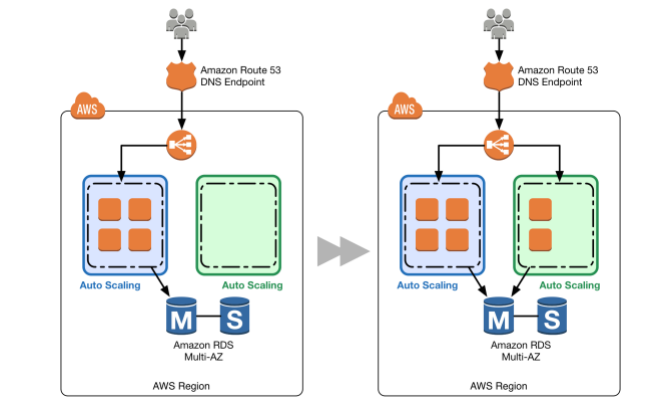Blue Green Deployments in AWS
Question
Your company has an application sitting on EC2 Instances behind an Elastic Load balancer.
The EC2 Instances are being launched as part of an Autoscaling Group.
Which of the following is an example of Blue Green Deployments in AWS?
Answers
Explanations
Click on the arrows to vote for the correct answer
A. B. C. D.Answer - C.
This deployment technique is given in the AWS Whitepaper.
As you scale up the green Auto Scaling group, you can take blue Auto Scaling group instances out of service by either terminating them or putting them in Standby state.
Standby is a good option because if you need to roll back to the blue environment, you only have to put your blue server instances back in service and they're ready to go.1 4 As soon as the green group is scaled up without issues, you can decommission the blue group by adjusting the group size to zero.
If you need to roll back, detach the load balancer from the green group or reduce the group size of the green group to zero.
For more information on Blue Green deployments, please visit the below URL:
https://d0.awsstatic.com/whitepapers/AWS_Blue_Green_Deployments.pdf
Blue Green Deployments is a release strategy that enables you to perform zero-downtime deployments. In this deployment strategy, you have two identical environments (blue and green), one of which is active (blue) and the other is inactive (green). You deploy new code changes to the inactive environment (green), verify that the new changes work correctly, and then switch the active environment to the new version (green). In this way, you can roll out updates with no downtime or impact to the end-users.
Let's look at each of the given options to identify which one of them represents the Blue Green deployment approach.
Option A: This option is using CloudFormation to create two completely separate stacks. Each stack is independent of each other, and they have no connectivity between them. To switch over, you need to deploy the resources in the second CloudFormation stack manually. This is not an example of Blue Green deployments.
Option B: This option uses Elastic Beanstalk to deploy two identical environments, one is active (blue) and the other is inactive (green). The new code changes are deployed to the inactive environment (green), and you can verify that the new changes work correctly. Once the changes are verified, you can use Rolling deployments to switch the active environment to the new version (green). This option represents the Blue Green deployment approach.
Option C: This option is not an example of Blue Green deployments because it involves re-deploying the application behind a load balancer that uses Auto Scaling groups. While creating a new Auto Scaling group is part of the Blue Green deployment strategy, this option does not have two identical environments and does not use a switching mechanism to roll out changes.
Option D: This option is not an example of Blue Green deployments because it uses OpsWorks to deploy two different versions of the application in two separate layers. While OpsWorks allows you to create multiple layers, it does not have a mechanism to switch between them to perform zero-downtime deployments.
In conclusion, option B is an example of Blue Green deployments in AWS, where Elastic Beanstalk is used to deploy two identical environments and Rolling deployments are used to switch between them.